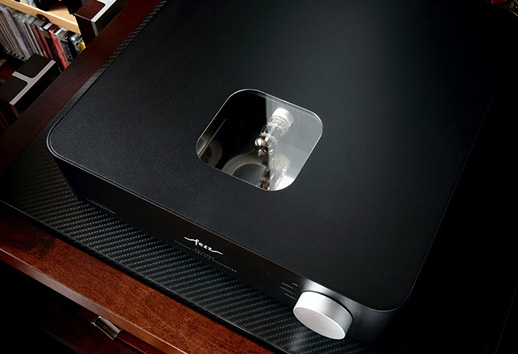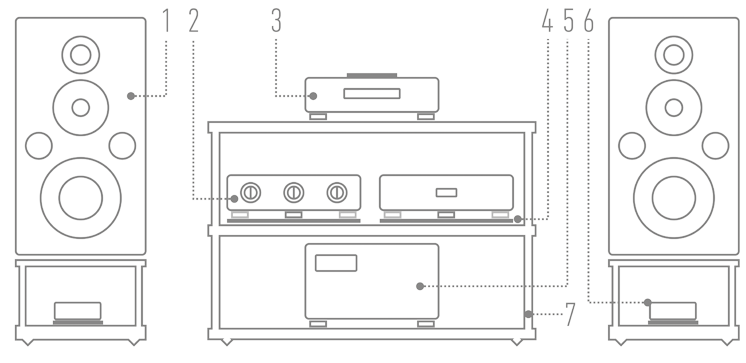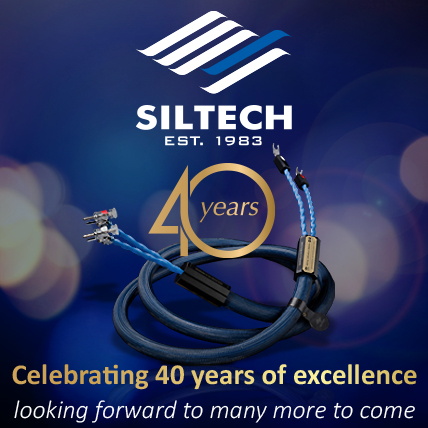|
DIGITAL-TO-ANALOG CONVERTER Fezz Audio
Manufacturer: FEZZ AUDIO |

|
Review
text by WOJCIECH PACUŁA |

|
No 239 April 2, 2024 |
|
˻ WORLD PREMIERE ˼
THE PREMIERE of the Equinox digital-to-analog converter from Fezz Audio was one of the highlights of last year's Audio Video Show (2023). The product itself was an interesting proposition, as it was the first DAC in the company's lineup. But it was flavored by the fact that it was designed by one of the world's most recognized Polish designers, Łukasz Fikus, known as LampizatOr. So you will also find the logo of this company on the front of the Equinox model. 
In the press materials sent out on this occasion, one could read:
In this information we find most of what is the essence of the tested device: a new external design, developed for the Evo series, and a tube output circuit. In addition, when we combine the price of the device with the person of the designer, it will come out that this is a unique product on the Polish market. | A few simple words... MACIEJ LACHOWSKI 
FOR A LONG TIME WE THOUGHT about building our own DAC, but - there's no denying it - Fezz Audio is a rather analog initiative. We've installed DACs in our equipment before, if only in the Torus 5060 solid-state amplifier, but building a separate DAC with a tube at the output is a completely different caliber of work. While traveling on business through Europe, together with Lampizator, that is, Łukasz Fikus, somewhere between other topics the topic of a converter under the Fezz Audio banner came up. At the time, I got the impression that Łukasz seemed to suddenly feel "called to the board", having said, and I quote: "Maybe let's do something together?" I have in my drawer several interesting, but not realized projects. Maybe, one of them will meet your requirements?" And that's where it all started. 
Upon my return, I sent Łukasz the general assumptions, then the design of the chassis in which the DAC would fit, and the information that we, i.e. Fezz/Toroidy, would take care of designing and making the appropriate transformer. After three weeks, we sent the said transformer to Lampizator, and we received the finished and commissioned DAC (still in the temporary enclosure) literally in the next several days. The project then entered a phase of tuning, listening and testing. Finally, the Equinox for a wider audience played for the first time on October 28th 2023 at the Audio Video Show in Warsaw. Putting it into production took us another three months. A set of finished, tested circuit boards is supplied by Lampizator, while the assembly and production of the transformers is done at Fezz. Personally, I am extremely pleased that the project managed to "get it right", because in audio we rarely see devices that have the logos of two manufacturers on the front. ML 
▌ Equinox EVO LET'S START WITH THE MOST IMPORTANT FEATURES: Equinox EVO is the world's only tube-based Lampizator licensed DAC, that is, one designed by Łukasz Fikus. Thus, it is also the cheapest DAC on the market with his company's logo. The products of his own range are priced in the high-end category, and are recognized and bought all over the world. The device premiered at the Audio Video Show 2023 (more → HERE {PL} and → HERE). As you could read in the press materials sent out on the occasion of the launch, the device did not come from nowhere, and was "the result of a long-standing collaboration between the two companies, as LampizatOr used transformers from Toroidy, the parent company of Fezz Audio, in its products. As Maciek said, the electronics are the design of Łukasz Fikus, while the chassis, power supply, external design and manufacturing are the domain of Fezz Audio, which, we read, makes it possible to "significantly reduce costs and, as a result, present the Equinox EVO at an affordable price, but at the same time opening the gateway to the high-end world." Asked by us about this, the head of Lampizator says:
Equinox is a digital-to-analog converter and nothing more. Phew... There is no file transport section, no output voltage control and no Bluetooth connectivity - it's a classic DAC. At its heart are two (dual mono), no longer produced, but excellent Burr-Brown PCM 1794 chips, accepting PCM digital signals up to 24 bits and 192 kHz. Their problem (contemporary) is o that they do not accept DSD signals. And that's why the whole circuit design was once put away in a drawer. Because contrary to what we read above, Łukasz Fikus is a huge fan of DSD. As he explains in an email to us, in the segment in which Fezz Audio operates, "the DSD issue may be less important, as the signal source will most often be either a CD transport or streaming." As he writes, as a result, he reformatted the Golden Gate 1 board to a flat shape and "married" it with a single ended triode circuit in the anode follower. And further:
The device is equipped with four digital inputs: two optical Toslink, coaxial RCA and USB Type B. An important, even very important, part of this design is the output tube. The tube here works in a resistive-capacitive amplifier circuit with a gain of 12x (21.5 dB), so it is a typical amplifying tube and not in a buffer (1:1) circuit, as is often the case in such devices. It is, let us remind you, a dual triode ECC82, in the tested unit of Russian Electro-Harmonix. In order to show it off well, there is a sliding glass in the upper part of the case, under which, horizontally, the tube is placed. Thanks to this solution, the user can easily shape and adjust the final sound of the device by replacing the tune supplied with the device with another one. The active input is selected using a large knob, next to which white-colored micro LEDs are placed. Unfortunately, there is no indication of the DAC's synchronization with the transport, and we don't know what parameters (bits, fs) the signal is sent to it. A cool thing is, located on the rear panel, a signal ground disconnect switch. It avoids the formation of a ground loop. Like all other products in the Evo line, the Fezz Equinox is also available in seven colors, so it will match the amplifiers of this Polish manufacturer. I'll say it again: the new series looks excellent. Well, and that LampizatOr logo on front! So it's high time to prepare nice, handy instructions for use. The ones we get with Fezz devices are... Maybe we should just leave it at that. ▌ SOUND ⸜ HOW WE LISTENED The Fezz Audio Equinox Evo DAC was tested in a HIGH FIDELITY reference system and compared to the D/A section of the Ayon Audio CD-35 HF Edition SACD player, which also worked as a CD transport - RCA input - and to the output section of the Lumin T3 file player, USB input, also working as a file transport. 
With the router, the player was connected via my system, consisting of a SILENT ANGEL N16 LPS dual LAN switch, with its two modules in series, powered by a TIGLON TPL-2000A cable and via a TIGLON TPL-2000L LAN cable; more on this → HERE {PL}; the router was powered by a JCAT Optimo 3 Duo power supply. 
The Ayon's digital output to the DAC's input was connected via an RCA→RCA Acrolink Mexcel 7N-DA6100 II cable, and the USB input was connected via a Tiglon TPL-2000U cable. The DAC was powered by a Harmonix X-DC350M2R Improved-Version cable. The DAC stood on the top shelf of a Finite Elemente Master Reference Pagode Edition Mk II rack on its feet. The rubber cones on which it stands protect it from slipping, so I didn't have to put any pads under it. ⸜ RECORDINGS USED IN THE TEST ⸜ a selection
⸜ CHARLIE HADEN, The Private Collection, Naim naimcd0108, 2 x CD (2007). WHEN I BOUGHT CHARLIE HADEN's album The Private Collection in 2007, I thought to myself that fifty years is already the "right" age and that people who turn it are more old than young. And that's because the bassist's birthday concert, recorded by Ken Christianson for the Naim label, was held to celebrate his fiftieth birthday. Today, when I have a year more myself, I see it differently. Completely different :) |
However, one thing has not changed - the fantastic energy emanating from these recordings. And it is this sensation of participation in something real that I have been looking for ever since when testing audio with this disc. Switching the input on the Ayon Audio preamplifier from the output of Ayon's analog SACD player to the output of the Fezz Audio DAC showed me that the device easily maintains that "something" that makes recordings roll, sail haltingly, flow into long fjords, only to flit between small islands in a moment. In a word - they are alive. 
The Equinox's output voltage level is much higher than the standard 2 volts, which to some extent, such is my experience in this type of situation, helps maintain the energy of the recording. Here, the energy is above average and is not only due to the fact that it is "louder." This is also achieved by presenting a clear, distinct attack of the sound, as well as by slightly opening up its upper range. The Ayon played Haden's double bass lower and in a fuller way. This instrument on this recording is boomy rather than selective, which is why it is so filled out at the bottom of the scale. The DAC, although it shortened its sound, pulling it back slightly behind the percussion, did not change the overall impression of fullness that this recording gives. Recorded on analog tape, it was digitally mastered for the CD release. But this "analog", manifested in the excellent energy transfer - because that's what, in my opinion, this technique excels at - was really brilliantly demonstrated by the Fezz DAC. I said that the sound of the DAC is based on a clear upper band. And it is. But it is not a brightening. A thing that in cheaper products could go wrong here has a purpose and is composed into a larger whole. Because when I listened to ˻ 1 ˺ Let’s Get Lost, the opening track of CHET BAKER's Chet Baker Sings and Plays album, I got creamy, almost honeyed vocals and darker instruments in the background. Even Bud Shank's flute was not bright, not to mention Russ Freeman's saxophone. It was a time, and we're talking about 1955, when Baker was just gaining recognition. Suffice it to say that in 1954 Baker won Down Beat magazine's annual poll in the "Best Trumpeter" category, beating out Miles Davis, among others. His great looks and nice voice also helped him achieve popularity. That's why in the second half of the 1950s he was still singing, not just playing trumpet. His voice is incredibly delicate - you can hear that this is not a singer. And yet his records which he sang on are among my favorites. And now - Equinox gave it all in a very cultured and well-balanced way. The voice was pleasant, it had that delicacy I speak of, but the instruments behind it had "nerve" and kept the pace. Yes, it was brighter and higher than with the Ayon, but it was neither too bright nor too high; it was different. It seems that this clarity was needed by the designer to get a good insight into the recording. This isn't a device from the same shelf as Lampizator's "regular" DACs, so it wasn't meant to compete with them. That's why it's not as resolving and doesn't have as deep a timbre. To balance this, to get similar effects it was decided, the way I see it, to have a clear sound. And it has succeeded exceptionally well. It's a palatable, thoughtful rendition with plenty of information, but which above all has very good energy - and that's its key feature. Without brightness and without emphasizing the attack of the sound, simply by shaping the timbre appropriately. So I listened to Baker's voice in comfort, with pleasure. The accompanying instruments, including the string section, were shown behind him, not piercing through, but always there, always laying the background for the velvet of the vocals. 
So we get a lot of information with Equinox. The layered, almost palimpset-like structure of the 1 ˺ Panopticom, the opening track of PETER GABRIEL's latest album I/O, was thus shown in a clear, accurate manner. The device did not over-dramatize the recording, even in the part where all the instruments enter In turn, in the quieter passages, it showed that richness of details, sounds, flavors of which this album is made. The space in the tested DAC is clear and distinct. This is one of the advantages of such a timbre setting and such a balance of energy. Gabriel's vocals given on a very long reverb surrounded me, and went quite far into the stage. Similarly, when in ˻ 2 ˺, along with the chorus he sang "In the court...", the sound surrounded me and was very carrying. Since the low notes are spot-on and clear rather than heavily filled, the stage size was good, but not anything above average. The volume of sounds is very nice, they do not lack anything, it is - I have already said several times - a well thought-out device. However, it is worth noticing that the accompanying track does not have problems with low midrange and is not too flashy. The Equinox is not like that, it has a very well-arranged timbre, but if something in the track is struggling, it will not be tolerated. Interesting, but the USB input offers a slightly lower set tone. Not much, it's still the same sound, but that was my impression. It's motoric, dense playing. When you play something like ˻ 5 ˺ Working Class Hero from the CAT POWER’s duo tribute-album, a track on which Chan Marshall is accompanied by Iggy Pop, it's the bass underneath that drives everything, pushes forward, keeps this lo-fi production moving. This recording is based on a sampled excerpt from the opening track of With or Without You by U2. And those high synth sounds were brilliantly contrasted with the bass. The foreground was shown quite close to me, as were Iggy's vocals. Therefore, the same recordings played from files and played from a CD transport will be shown slightly differently. CDs will play in a more resolving manner. Files, on the other hand, will play denser and lower. I would say they will be reproduced in a more silky way. Thus, to the energy and clarity that I have already written about, the filling of the lower midrange is added. Superbly reproduced, then, was the ˻ 1 ˺ For Your Love track by Danish Spanish guitar master JACOB GUREVITSCH, released as a digital single to accompany the 2013 album El Terreno. It features classical guitar in the lead role, with percussion, trumpet and synthesizer as background. But it's when, midway through the second minute, the aforementioned trumpet of legendary Cuban trumpeter Arturo Sandoval sounds off that it gets thick, gets soft. That's why I would treat the USB input as the main one. The RCA input will show more detail, convey a clearer picture of the presented world. And the best remasters, the best recordings, the best CD releases will sound great with it. However, when things get jumpy on the disc, when there is a piling up of sounds with simultaneous high compression, the DAC will get slightly "stuck". In the sense that clarity will disappear somewhere. At the same time, against other devices of this type from the vicinity of up to PLN 10,000, it will still be excellent playing, to be clear. But when you play something through the USB input, it won't matter how loud you play or what kind of music you listen to, because the sound will get softer and smoother. And the clarity and selectivity I've heard from CDs won't be much worse. So both Gurevitsch's delicate playing and the sometimes powerful, emotionally dense recordings from JEFF BECK's concert album Who Else! will be emotionally grounded in us. ▌ Summary NO MATTER WHAT source we use, it will be difficult after listening to this DAC to go back to the sound of other devices in this price range without feeling that we are losing something. For this is an incredibly energetic and clear sound. Clear in the sense that it brings a lot of information about the recording itself and the details. It doesn't pull them out and throw them in our faces. And yet these will be event-rich reproductions. And even with a strong beat, let it be ˻ 1 ˺ One Night/All Night, a track from the JUSTICE and TAME IMPALA single of the same title, the DAC will keep its full composure, holding the tempo, showing an internally rich, big picture. You will greatly enjoy the bass of this recording and the shimmering, "floating" timbres. Equinox appears, therefore, to be an extremely interesting product. On the one hand, it is geared towards transparency and detail, while on the other, using this information in a reasonable way. It offers an open sound, which with files is also complemented by soft, dense bass and a creamy midrange. With CDs the selectivity will be above average, so good releases will shine with it. We will finish the listening experience with a smile on our face every time. ▌ DESIGN EQUINOX, a D/A CONVERTER from Fezz Audio, is part of the Evo series. In truth, it's difficult to consider it a series, as it simply means that the devices have new enclosures, which distinguishes them from the older series. However, the DAC is distinguished by the fact that it did not have an equivalent before, so it is one of the company's first completely new products. » FRONT AND REAR • The appearance of the Evo series is excellent, as we have mentioned several times with other devices. The case is made of steel plates and has curved sides. Several color versions are available, but in each the large knob on the front panel is silver. With this knob we select the active input. Corresponding to it are small white LEDs. The lettering next to them is quite dark, making it difficult to read, especially in twilight. Besides, we still have an illuminated company logo on the front panel. On the back, the nice, screw-on and Teflon-insulated RCA jacks catch one’s eyes - these are the output jacks. A similar socket, but the input one, is an average, not gold-plated unit soldered to the board. Next to it we find two more Toslink optical inputs and a USB input. The IEC supply voltage socket has been integrated with a fuse, which can be replaced with a better one in the future, thus improving the sound. This can also be achieved by using some third party anti-vibration feet. In its basic version, the DAC stands on beautiful, handy rubber cones. Sound improvement will also be achieved by replacing the electron tube operating in the analog output stage. Here the manufacturer uses an Electro-Harmonix ECC82 EH double triode from current Russian production. As we have written about it many times, there is a shortage of tubes on the market from other manufacturers that have repeatable parameters, so equipment manufacturers are largely doomed to the Russians. But it is worth remembering that this should change in the future. The tube is exposed in a window visible from above. The interior of this chamber was formed from a reflective stainless steel sheet. It is covered in turn by a glass plate. It has been cleverly fixed so that it slides sideways, and is held in place by magnets when closed. The power switch is mechanical and has been placed on the underside of the case. » INSIDE • The electronics are assembled on a single, two-layer circuit board, which also houses the power supply. Only the USB input chip with Atmel DSP chip was given a separate board. The board was bolted to a small metal screen, and this was bolted to the rear panel. 
The actual converter and output circuits are located on the main board. However, since its front has been shielded, you can't see them. However, the manufacturer states that these are two Burr Brown PCM 1794 chips with an AKM AK4118 digital receiver. The tube, plugged into a ceramic socket soldered to the same board, works as an output buffer, not in the amplification circuit. It is not included in the feedback loop. Polypropylene coupling capacitors are used at the output. The power supply looks exceptionally nice and it's what gives this unit its mass. The toroidal transformer from parent company toroidy.pl has been encased in a shield and screwed not directly to the bottom of the chassis, but to sections that raise it above it. There are several secondary windings coming out of the transformer, and eight sizable capacitors help suppress mains ripple. The connections are made in a very "clean" way, and the wires are grouped so that they do not interfere. To the output, the signal is routed via shielded Tasker mounting interconnects, made of OFC copper. The cables are quite long. Let me remind you that Tasker is an Italian company with more than 45 years of experience. ● ▌ Technical data (according to the manufacturer)
Output tube type: ECC82/12AU7 
THIS TEST HAS BEEN DESIGNED ACCORDING TO THE GUIDELINES adopted by the Association of International Audiophile Publications, an international audio press association concerned with ethical and professional standards in our industry, of which HIGH FIDELITY is a founding member. More about the association and its constituent titles → HERE. |

|
Reference system 2022 |
|
 1) Loudspeakers: HARBETH M40.1 |REVIEW| 2) Line preamplifier: AYON AUDIO Spheris III Linestage |REVIEW| 3) Super Audio CD Player: AYON AUDIO CD-35 HF Edition No. 01/50 |REVIEW| 4) Stands (loudspeakers): ACOUSTIC REVIVE (custom) |ABOUT| 5) Power amplifier: SOULUTION 710 6) Loudspeaker filter: SPEC REAL-SOUND PROCESSOR RSP-AZ9EX (prototype) |REVIEW| 7) Hi-Fi rack: FINITE ELEMENTE Pagode Edition |ABOUT| |
|

|
Cables Analog interconnect SACD Player - Line preamplifier: SILTECH Triple Crown (1 m) |ABOUT|Analog interconnect Line preamplifier - Power amplifier: ACOUSTIC REVIVE RCA-1.0 Absolute-FM (1 m) |REVIEW| Speaker cable: SILTECH Triple Crown (2.5 m) |ABOUT| |

|
AC Power Power cable | Mains Power Distribution Block - SACD Player: SILTECH Triple CrownPower (2 m) |ARTICLE| Power cable | Mains Power Distribution Block - Line preamplifier - ACOUSTIC REVIVE Power Reference Triple-C (2 m) |REVIEW| Power cable | Mains Power Distribution Block - Power amplifier - ACROLINK Mexcel 7N-PC9500 |ARTICLE| Power cable | Power Receptacle - Mains Power Distribution Block: ACROLINK Mexcel 7N-PC9500 (2 m) |ARTICLE| Power Receptacle: Acoustic Revive RTP-4eu ULTIMATE |REVIEW| Anti-vibration platform under Acoustic Revive RTP-4eu ULTIMATE: Asura QUALITY RECOVERY SYSTEM Level 1 |REVIEW| Power Supply Conditioner: Acoustic Revive RPC-1 |REVIEW| Power Supply Conditioner: Acoustic Revive RAS-14 Triple-C |REVIEW| Passive filter EMI/RFI: VERICTUM Block |REVIEW| |

|
Anti-vibration Speaker stands: ACOUSTIC REVIVE (custom)Hi-Fi rack: FINITE ELEMENTE Pagode Edition |ABOUT| Anti-vibration platforms: ACOUSTIC REVIVE RAF-48H |ARTICLE| Isolators: |

|
Analogue Phono preamplifier: Phono cartridges:
Clamp: PATHE WINGS Titanium PW-Ti 770 | Limited Edition Record mats:
|

|
Headphones Headphone amplifier: AYON AUDIO HA-3 |REVIEW|Headphones: Headphone Cables: Forza AudioWorks NOIR HYBRID HPC |
main page | archive | contact | kts
© 2009 HighFidelity, design by PikselStudio,
projektowanie stron www: Indecity







 The main goal in the design of the Fezz Audio Equinox EVO DAC was not perfect measurements, but listening pleasure, extraordinary timbre and the best possible sound. What is important is that in this case we are not dealing with a tube buffer, but with the signal amplified using tube. As a result, the sound is very hard to compare to well-known products, according to the manufacturer, it is closest to products several times more expensive. Noteworthy, of course, is also the visual design.
The main goal in the design of the Fezz Audio Equinox EVO DAC was not perfect measurements, but listening pleasure, extraordinary timbre and the best possible sound. What is important is that in this case we are not dealing with a tube buffer, but with the signal amplified using tube. As a result, the sound is very hard to compare to well-known products, according to the manufacturer, it is closest to products several times more expensive. Noteworthy, of course, is also the visual design. 





















